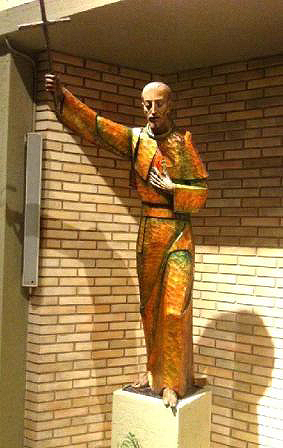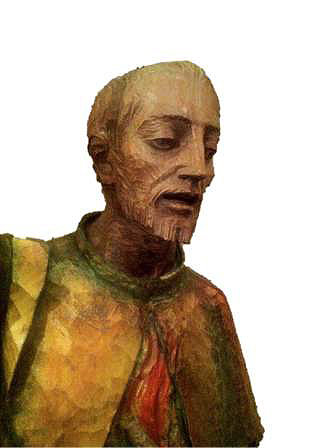The piece of the month of December 2015
THE SCULPTURE OF SAINT FRANCISCO JAVIER IN THE PARISH CHURCH OF SAN FERMÍN IN PAMPLONA, THE WORK OF JOSÉ LÓPEZ FURIÓ (1969)
Jorge Aliende Rodríguez
Historian and journalist
José López Furió (Benimaclet, Valencia, 1930-Pamplona, 1999) was perhaps the most important sculptor of Navarre in the 20th century, having signed hundreds of sculptures from Pamplona all over the world, most of them in the Comunidad Foral.
Son of the sculptor José López Catalá (Benimaclet, 1903-1958), he studied at the Royal Academy of Fine Arts of San Carlos in Valencia while working in the family workshop. Once he finished his academic training , he arrived in 1957 in Navarre after approve the competitive examinations to become a drawing teacher at the Instituto Laboral de Alsasua.
During his stay in La Barranca he received his first commission as an independent sculptor: the new images for the parish church of Nuestra Señora de la Asunción in Alsasua. Those carvings that today dress the perimeter wall of the naves served him as card of presentation before who became his main client: the Church.
In 1964 he moved to Pamplona to teach class in the high school El Redín, since the activity professor was present uninterruptedly during all his degree program. Later he would also be professor of the disappeared high school San Miguel de Aralar.
Dedicated from plenary session of the Executive Council to sacred imagery, his particular style as a neo-figurative artist is summarized in a union between modernity and avant-garde whose result is a work that he himself defined as "modern, but with classic lines. Simplified and stylized". The stylization of his figures is synthesized in the lengthening of the canon and the fineness of the bodies and faces, as well as the longitudinal postures chosen. The simplification is given in the absence of superfluous attributes and folds, gestures and other baroque elements.
The iconography of his production is dominated by images of the Virgin, but there are not few crucifixes and different sets made for dozens of churches. To his gouge is also due a good issue of sculptures of St. Francis Xavier in Navarre (such as those of seminar, Christ the King of Pamplona or the Assumption of Alsasua), one of the most outstanding being the one that occupies this study.

San Francisco Javier. Parish Church of San Fermín. District of La Milagrosa. Pamplona
On the right side of the parish church of San Fermín in the La Milagrosa district of Pamplona is a wooden sculpture of the Jesuit saint, carved for the blessing of the church, which took place on 20 March 1969 by the bishop of Tudela, Ángel Riesco.
The patron saint of Navarre raises the cross with his right arm in a triumphant attitude and takes his left arm to his chest in flames, as if to support the human pain caused by the divine abrasion. The face of Saint Francis, far removed from the hieratic style customary in the sculptor's imagery, is that of a man of mature age, conveying a certain pain heroically endured by one who seems to use his strength to cling to the cross. The image, which measures 160 cm, reaches 2 metres at the end of the cross.

Saint Francis Xavier. Detail
His gaze, where decision overcomes fatigue, is directed to the left side. The right foot is quite far behind the right (both barefoot) and the saint leans slightly. In an attempt to make the scene more unstable -as usual-, the author takes the saint's foot off the granite pedestal that raises it above the ground.
The binomial tiredness-hope that generates this expressiveness in the image can find its explanation in some of the sensations described by Javier in the epistles to his Jesuit companions in Europe:
"...many times it happens to me to have my arms tired from baptizing, and not being able to speak of so many times saying the Creed and the Commandments in his language of them (...) there are so many consolations that God our Lord communicates to those who walk among these gentiles converting them to the faith of Christ, that if there is contentment in this life, this one can be said".
The most novel feature of the sculpture in question is the beautiful coppery polychrome that covers the cassock of St. Francis (made by Agustín Guillén, partner of López Furió in dozens of commissions), creating greenish shadows in the most marked folds. Unlike most of the Valencian artist's sculptures, which barely received a very watery layer of paint that gave prominence to the arboreal soul on which the brush rested, the painting of this piece contributes to highlight the marks of the gouge on the wood, an unmistakable hallmark of the Valencian artist's works.
The images of the Immaculate Conception and the patron saint of the parish, Saint Fermín, located around the altar of the temple are also by the hand of López Furió, as was the iron Crucifix that was originally placed next to the door of the parish and that today is worshipped in a Cistercian Shrine of Our Lady of Fair Love of the monastery of Santa María la Real de la Oliva.
The three images of the sculptor in the temple give an idea of the technical quality and artistic personality achieved by the sculptor who made for Pamplona sets such as the Assumption of St. John, the Pietà of Christ the King or the Sacred Heart of the seminar of Pamplona. López Furió was a prolific and discreet artist who today, barely 15 years after his death, is beginning to receive the attention he deserves from the academic world.
bibliography
-ALIENDE RODRÍGUEZ, J., La escultura religiosa de José López Furió (1930-1999) en la ciudad de Pamplona, work Fin de Degree, Universidad de Navarra, 2014.
-ALIENDE RODRÍGUEZ, J., "La escultura de José López Furió fuera de Navarra", Príncipe de Viana, 262 (2015), pp. 929-940.
-DOMINGO, J. M., "Francisco Javier, siempre más allá", "Santos y santas". Centre de Pastoral litúrgica, Barcelona, 2006.
